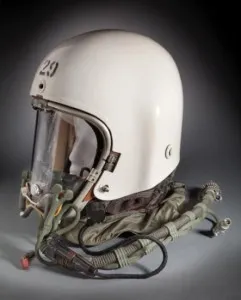America — and Gary Powers — Caught Red-Handed
On this day in 1960, CIA pilot Gary Powers was shot down over the USSR. Read how a military maneuver became an international incident
/https://tf-cmsv2-smithsonianmag-media.s3.amazonaws.com/filer/20110819095004Francis-Gary-Powers_model_nasm.jpg)
Seventy thousand feet above the USSR. CIA pilot Francis Gary Powers is flying a U-2 plane, taking photos of military installations and objects of interest on the ground. The Americans believe that the U-2 is nearly invincible against the Soviets, since it travels at such high altitudes. What they don’t know is that the USSR has developed a new surface-to-air missile capable of reaching such heights—and what Powers doesn’t realize is that one of these missiles is right behind his plane, about to take him down. After ejecting from the plane, parachuting to the ground, and getting interrogated thoroughly, he is convicted to three years in a Soviet gulag on this day in 1960.
Because Powers was captured, the event quickly escalated into an international incident. “It became a fairly embarrassing episode for the United States because, throughout this whole time period, they were denying that they were doing such flights,” says Alex Spencer, a curator at the Air and Space Museum. Initially, the U.S. government claimed that technical difficulties had caused a weather observation plane to crash. Once the USSR announced they had both Powers and pieces of the plane in custody, the story collapsed.
The public was stunned that an American pilot had been captured in a place he wasn’t even supposed to be. “It was pretty shocking, because nobody knew that this plane even existed, except in very high circles,” says Spencer.

At the height of the Cold War, the Soviets played up the episode for all it was worth. “There was a meeting to be held between President Eisenhower and Khrushchev at this time, and what ended up happening was, the Soviets took advantage of the propaganda value of the shoot down, and ended up canceling this important meeting,” Spencer says. Powers endured a high-publicity trial and was found guilty of espionage. He was sentenced to three years in prison, seven years of hard labor, and forced to apologize to the authorities.
“He was essentially just in a standard Soviet gulag as a convicted spy, and spent his time as all Soviet prisoners do, at hard labor and such. So it was pretty miserable, to say the least,” says Spencer. Two years later, a prisoner swap was arranged, and Powers returned home.
The Air and Space Museum has a total of 26 artifacts that Powers had in his possession at the time of his return, which were donated to the museum by his family. Among other items, a winter cap, mittens (which he had knitted himself in prison), an overcoat, long underwear, a set of Russian dolls, a hat, rug, a watch, and his pilot’s badge are on display in the “Looking at Earth” gallery. In Russia, too, the episode is remembered in museums, including the Central Museum of the Armed Forces in Moscow and Monino Air Force Museum, which has fragments of the actual U-2.
One might imagine Powers would come back to a hero’s welcome, but in the ultra-paranoid Cold War America, he was greeted with suspicion. Pilots were supposedly supplied with suicide tablets, and some felt Powers should have taken one rather than being imprisoned by the enemy. Many military men “didn’t feel that he had done his job, and so he was kind of shunned within the community, because they felt that he had embarrassed the country,” says Spencer. “He has kind of this career afterward where he just kind of goes from job to job to job.” While working as an airborne reporter in Los Angeles, his helicopter tragically crashed on August 1, 1977, killing Powers at the age of 47.
Finally, 40 years after the incident, Powers posthumously got his due. In 2000, his family accepted the Distinguished Flying Cross, the Prisoner of War Metal, and the CIA’s Director’s Medal on his behalf. “It’s important to make sure he’s honored for his contribution,” his son, Francis Gary Powers Jr. said. “He never thought of himself as a hero, he thought of himself as a pilot.”
/https://tf-cmsv2-smithsonianmag-media.s3.amazonaws.com/accounts/headshot/joseph-stromberg-240.jpg)
/https://tf-cmsv2-smithsonianmag-media.s3.amazonaws.com/accounts/headshot/joseph-stromberg-240.jpg)